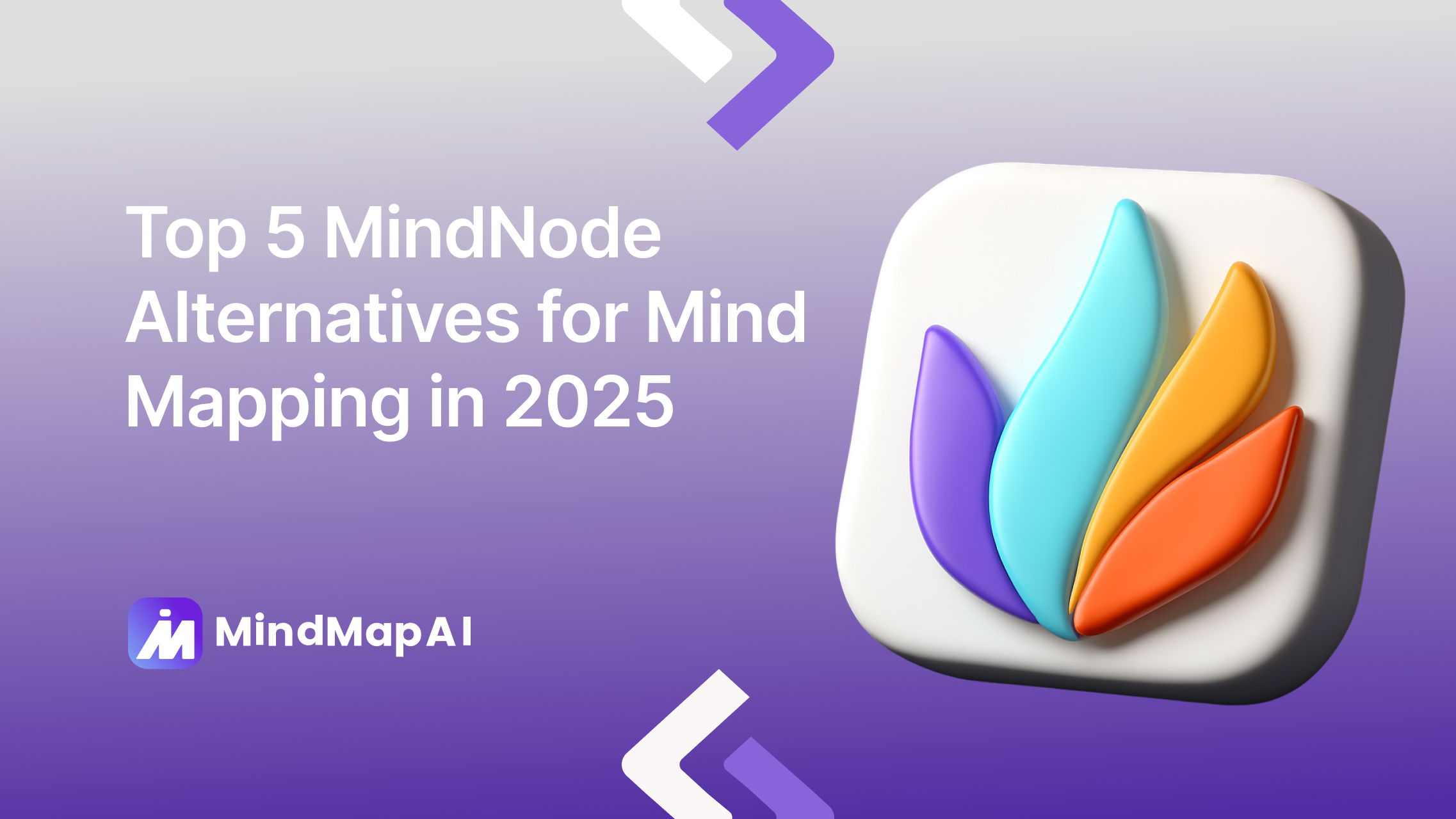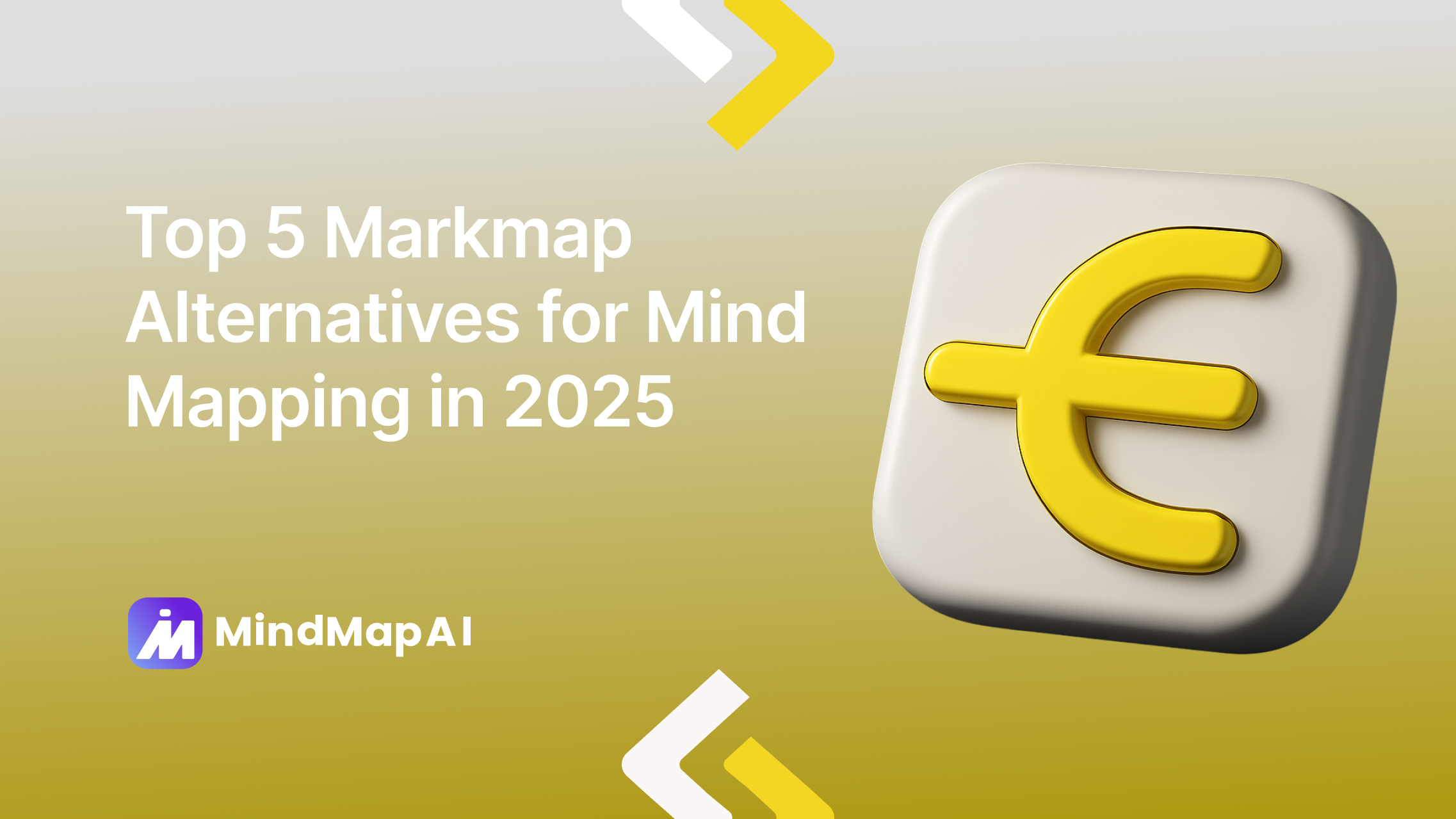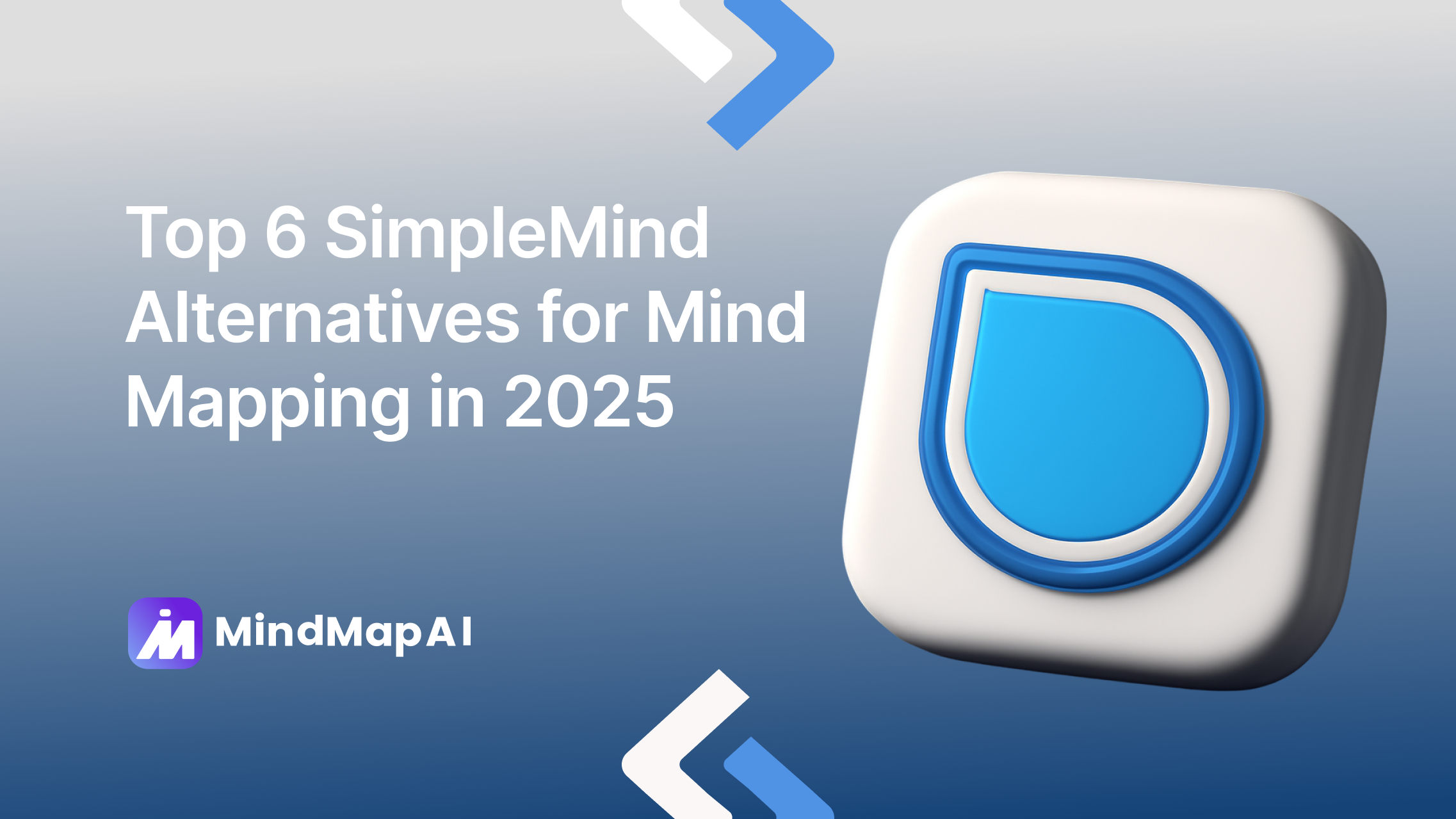
Top 6 SimpleMind Alternatives for Mind Mapping in 2025
SimpleMind is a well-established cross-platform mind mapping tool known for its clean design, one-time purchase model, and intuitive layouts. It helps users organize thoughts, brainstorm, and create visually appealing maps with features like free-form placement, auto-layouts, autofocus, notes, links, and PDF exports. Its accessibility across devices (Mac, Windows, iOS, Android) makes it a convenient choice for both personal and professional use.
That said, SimpleMind keeps its focus on simplicity. Users looking for advanced mind mapping, multi-format imports, or automation for brainstorming and task planning may find its feature set limited compared to newer AI-driven platforms.
This guide explores the best SimpleMind alternatives in 2025, tools that go beyond traditional mapping with AI features, deeper collaboration, and richer export options to support modern workflows.
Turn your ideas into an AI mind map in seconds
1. MindMap AI

Why it stands out
Drag-and-drop PDFs, videos, audio, images, CSVs, or text and instantly get an editable mind map. MindMap AI’s Copilot Chat responds to plain-English commands like “expand level-3 nodes” or “summarize this branch”, while Second-Order Connections automatically identifies and links related ideas across your map. Unlike traditional tools like SimpleMind, which rely on manual input, MindMap AI brings AI-driven automation to brainstorming, research, and project planning, enabling faster insights and smarter idea organization.
Key Features
Multi-format ingest to structured maps: Text, CSVs, PDFs, audio, video and images.

Copilot Chat: Expand, refine, summarize, and connect ideas directly on the canvas.

Second-Order Connections: Automatically identifies related ideas across the map.

Effortless sharing: Share maps privately or publicly with links.

Flexible exports: PNG, SVG, PDF, Markdown, CSV, and project files for offline use.

Version history & cloud storage: Track all changes and access maps anytime, anywhere.
Pros
AI-Powered Assistance: Generate structured maps, expand topics, summarize content, and focus on branches with AI.
Supports multiple input formats: PDFs, CSVs, text, images, audio, and video.
Cloud-based accessibility: Web and mobile apps (iOS/Android) provide seamless access without installation.
Full-featured free plan: Unlimited manual maps, watermark-free exports, and version history.
Flexible pricing options: Affordable monthly, yearly, or lifetime plans; add-on credits available.
Student discounts & regular updates: Continuous improvements and educational pricing.
Cons
No desktop app yet: Accessible via web and mobile only.
No real-time co-editing: Team collaboration currently limited to sharing links.
Pricing
Free: 100 AI credits/month.
Basic: $3.74/month billed yearly (or $7.49/month monthly) - 2,000 AI credits included.
Pro: $7.49/month billed yearly (or $14.99/month monthly) - higher AI credit allowance.
Add-on credits: Starting from $4.99.
Lifetime plan: One-time purchase available.
Discover how MindMap AI stacks up against SimpleMind in features, pricing, and usability
2. MindMup
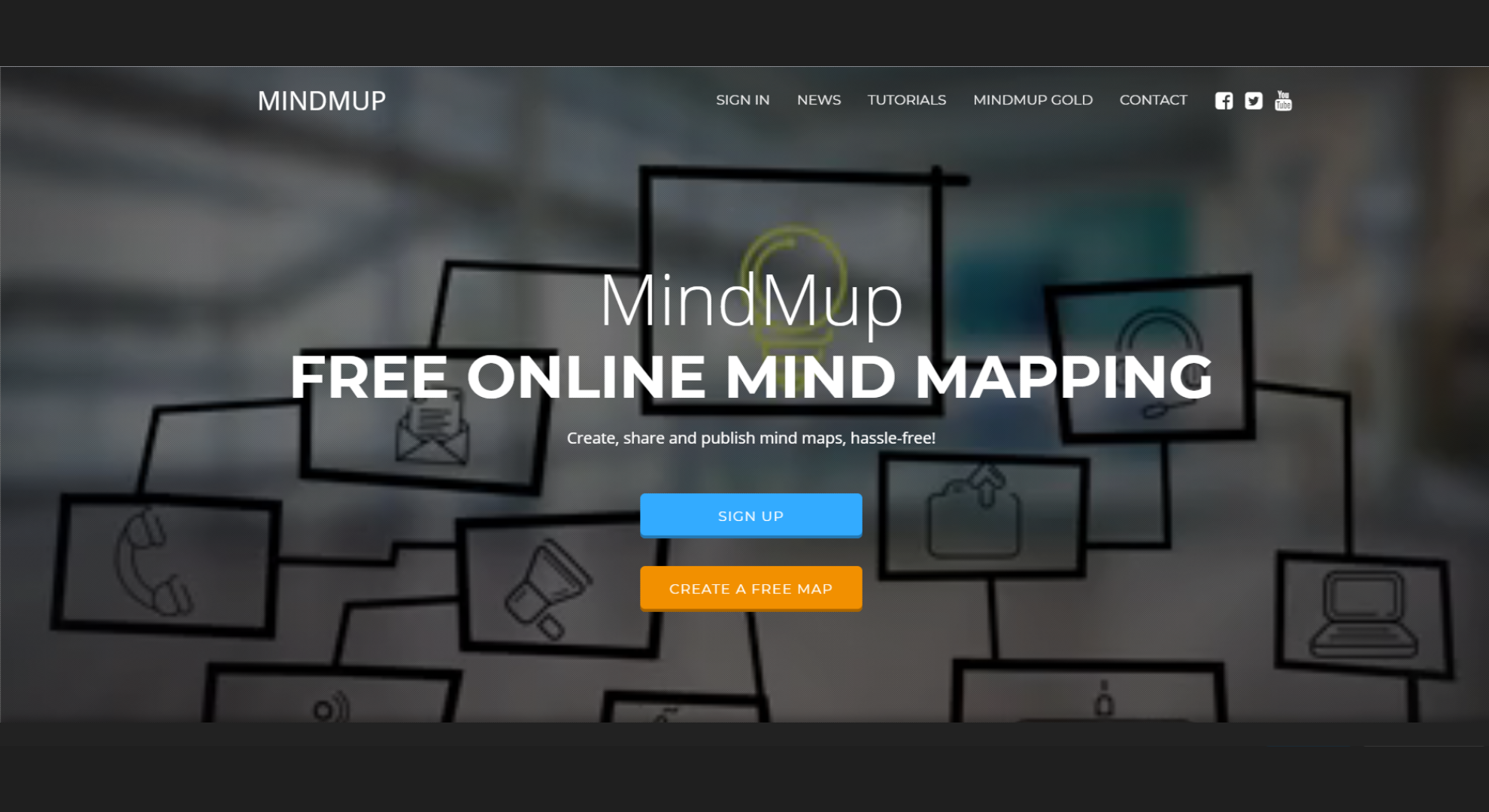
Why it stands out
MindMup is a lightweight, cloud-first mind mapping tool that prioritizes simplicity and seamless collaboration. Its Google Drive integration and link-based sharing make it ideal for users who want to create, store, and share maps quickly without complex setups.
Key Features
Real-time collaboration on paid Gold tiers.
Free tier with size limits (100 KB) and time-limited map publishing.
Supports Google Drive and Teams workflows for easy integration into existing processes.
Pros
Affordable Personal Gold plan ($2.99/month).
Simple, share-friendly, and ideal for quick brainstorming sessions.
Cons
No built-in generative AI to automate idea expansion.
Free tier comes with storage and export limitations.
Pricing
Free (limited)
Personal Gold $2.99/month
Organization/Team plans available.
3. Markmap
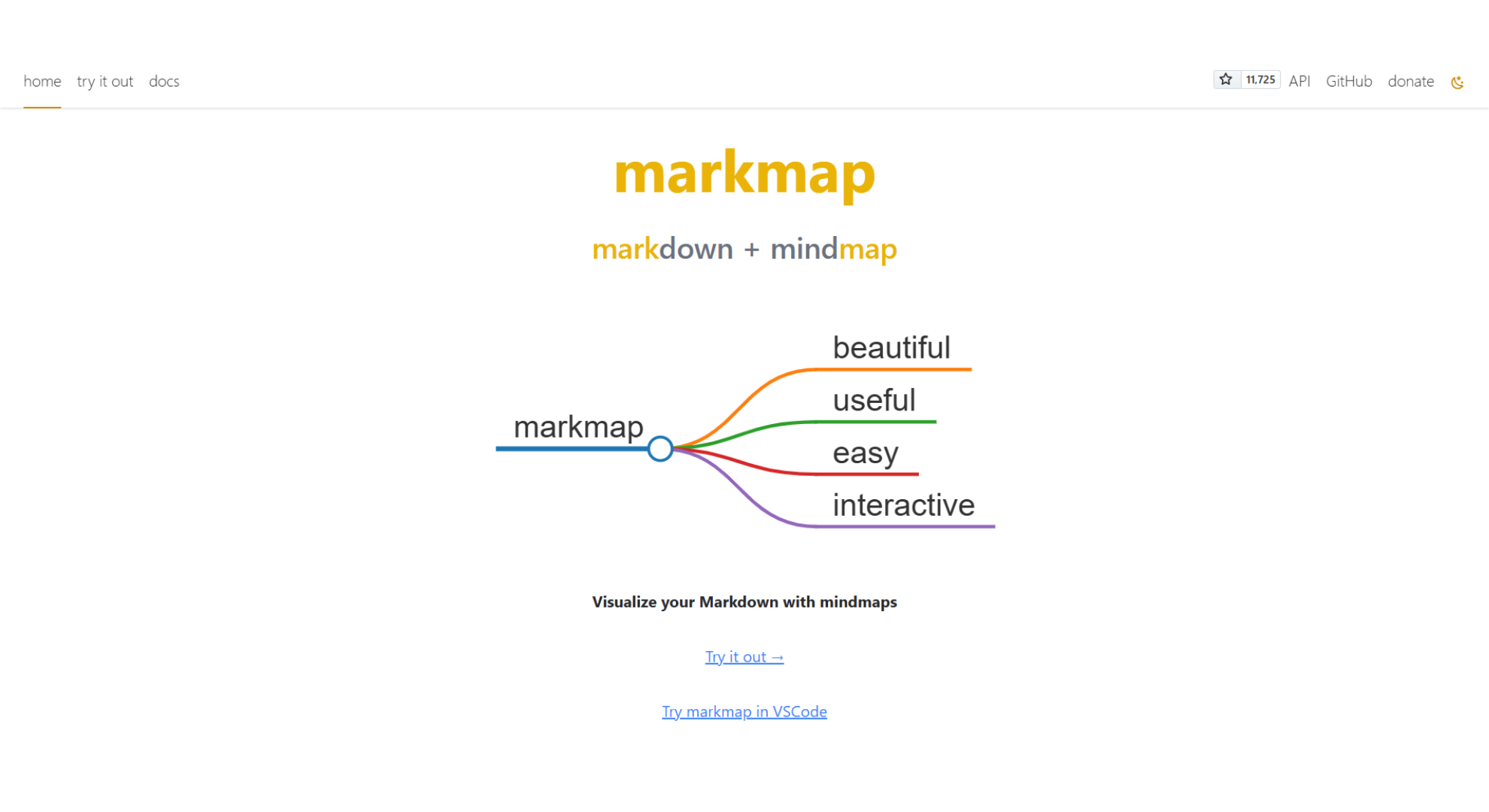
Why it stands out
Markmap is a unique, developer-friendly mind mapping tool that transforms Markdown documents into interactive, visual mind maps in real time. Unlike traditional drag-and-drop mind mapping apps, Markmap appeals to users who prefer text-based workflows, including developers, technical writers, and content creators managing documentation or knowledge bases. By combining simplicity with flexibility, Markmap makes it easy to convert structured notes into navigable visual maps, helping teams and individuals understand complex information at a glance.
Key Features
Live Markdown-to-mind-map rendering: Automatically turns Markdown headings and lists into an interactive, collapsible map.
Real-time updates: Changes in the Markdown source instantly reflect on the map, ensuring a dynamic workflow.
Fully open-source: Self-host the tool or use the online demo, with full control over customization.
Integration-friendly: Can be embedded in GitHub pages, blogs, and documentation sites for seamless visualization.
Pros
Completely free and open-source, encouraging customization and community-driven improvements.
Fits naturally into developer and content-creator workflows, especially for projects using Markdown, Git, or static site generators.
Embeddable on websites or documentation platforms, enhancing knowledge sharing and visual understanding.
Minimal learning curve for those familiar with Markdown; supports complex hierarchical structures without clutter.
Cons
Lacks traditional project management, planning, or collaboration features found in mainstream mind mapping software.
Steep learning curve for users not familiar with Markdown syntax or text-based formatting.
Limited visual customization options compared to full-fledged desktop or cloud mind mapping apps.
Pricing
Free / open-source (GitHub). Users can self-host or contribute to the project.
4. Inspiration
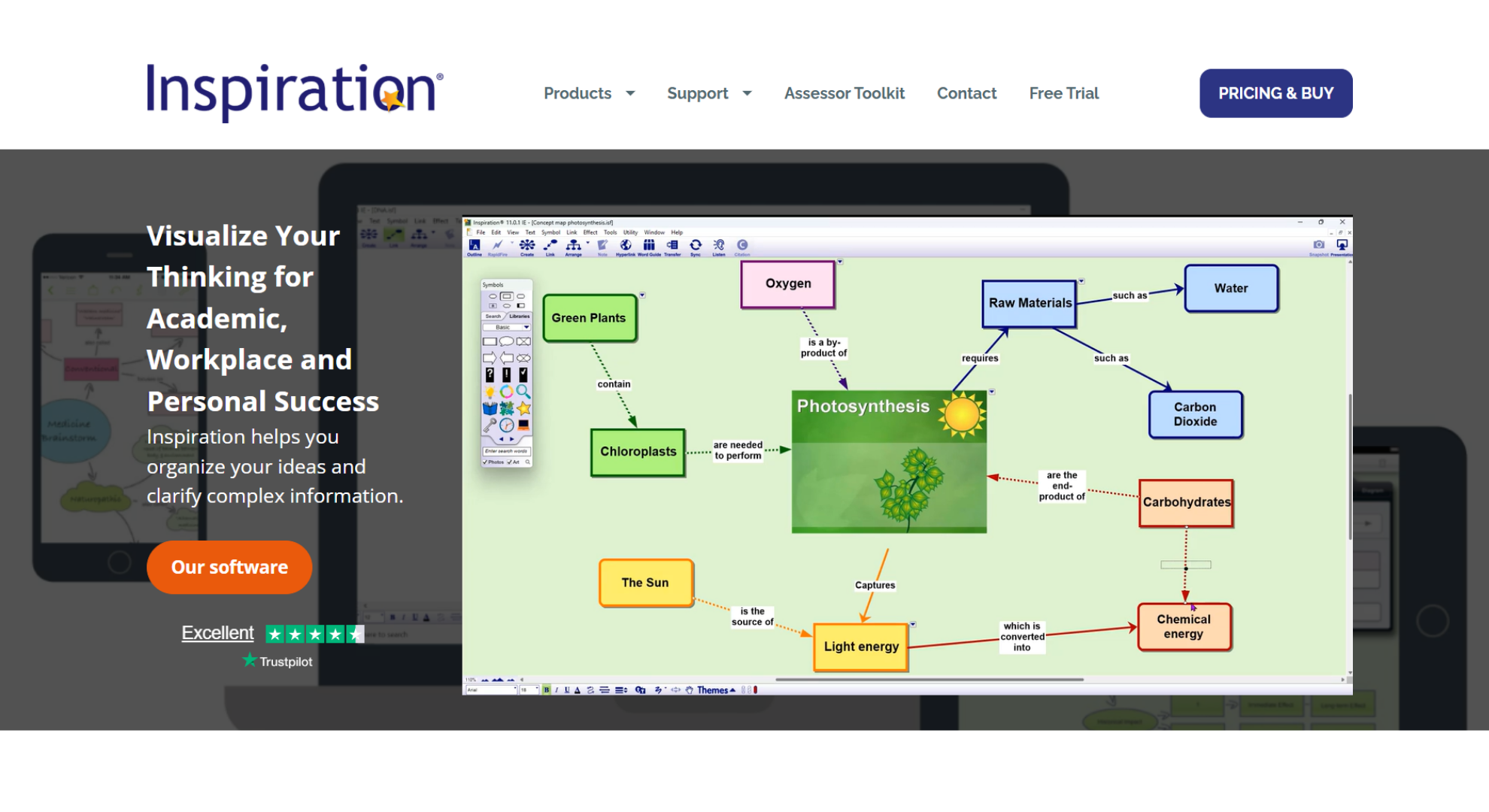
Why it stands out
Inspiration is a purpose-built educational mind mapping and visual learning tool that combines traditional mind mapping, concept mapping, and outlining into a single intuitive workspace. Its design focuses on clarity, simplicity, and accessibility, making it ideal for students, educators, and trainers who want to transform ideas into structured visuals quickly. The software supports both individual learning and classroom workflows, and its perpetual licensing model makes it a popular choice for schools and institutions seeking cost-effective, long-term solutions.
Key Features
Desktop-based Inspiration 11 with offline capabilities for Windows and macOS.
Cloud-based Inspiration RD version available for Mac and Chromebook, enabling cross-device access.
Single-user perpetual licenses as well as organization- or site-wide licensing options.
Built-in lesson planning and concept diagramming tools tailored for educators.
Pros
One-time purchase model with no recurring subscription, allowing installation on up to two PCs per license.
Education-centric interface supports both visual learning and lesson planning.
Training materials, templates, and structured guidance make it easy for beginners to adopt.
Supports a wide range of visualizations, including concept maps, outlines, and workflow diagrams, all in one tool.
Cons
Interface and functionality are strongly tailored to educational contexts, which may feel restrictive for corporate or professional project management workflows.
Limited cloud sync and collaboration options compared to modern AI-first or cloud-native mind mapping platforms.
Pricing
Perpetual single-user license (one-time cost; regional resellers set final price).
Organization/site licenses available for schools, districts, and institutions.
5. MindMapper
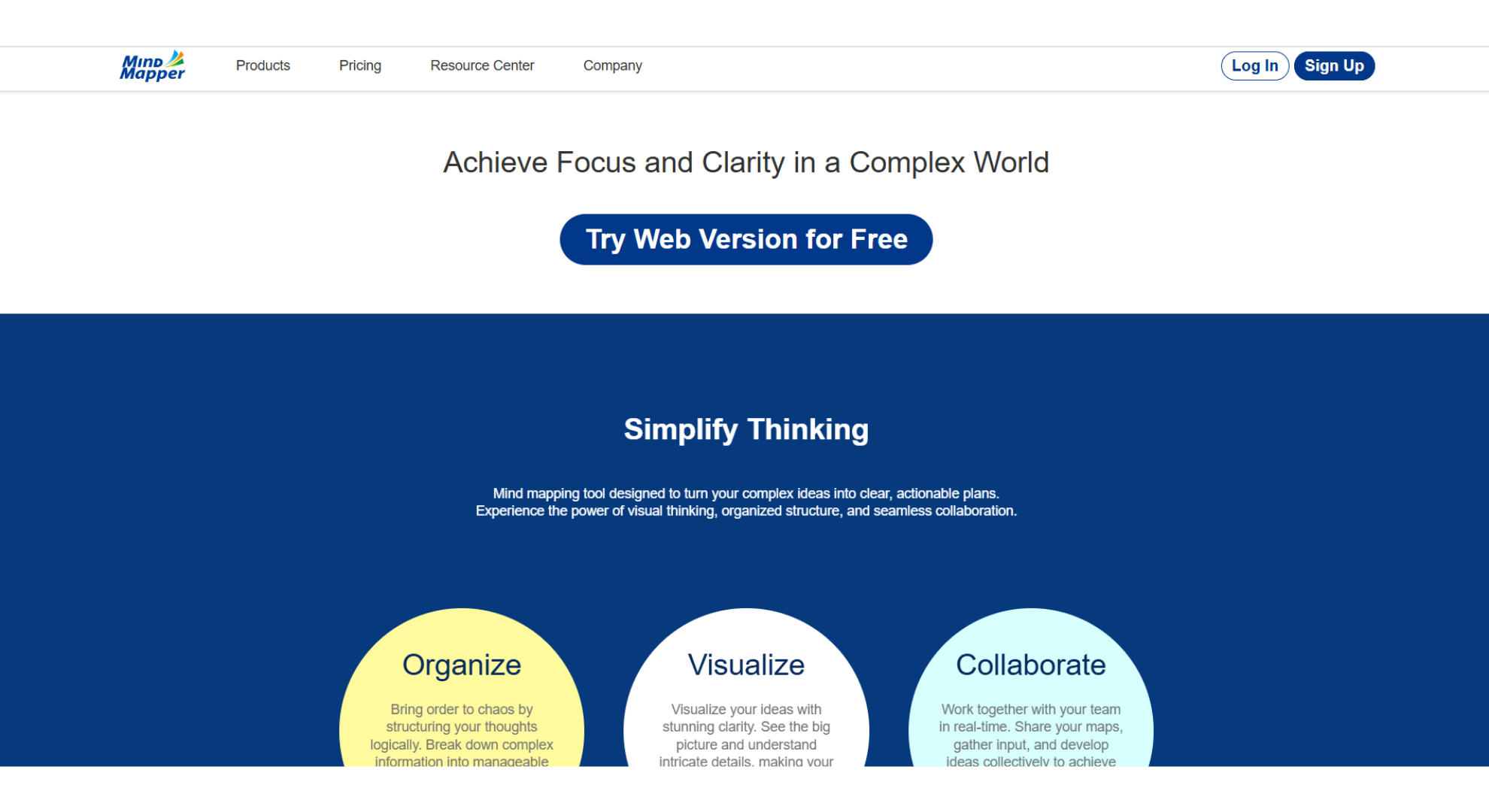
Why it stands out
MindMapper is a long-standing Windows-based mind mapping tool that excels at combining classic diagramming with structured planning. Its unique blend of mind map creation, dashboard views, and integrated planner makes it a strong choice for users who need to organize ideas alongside actionable project plans. The Arena edition further enables team collaboration, allowing groups to work together in offline or corporate environments where cloud-first solutions may not be suitable.
Key Features
Standard, Pro, and Arena editions with perpetual licenses for one-time purchase.
Integrated workspace combining mind mapping, diagramming, and planning tools.
Optional team collaboration in Arena edition, including shared maps and project management views.
Offline support ensures productivity even without internet connectivity.
Pros
Designed for offline use, ideal for corporate Windows environments or individual productivity.
Strong structured planning features, including built-in dashboards and planners, which go beyond standard mind mapping.
Minimal learning curve for users familiar with Windows and desktop applications.
Arena edition supports team collaboration without requiring cloud dependency.
Cons
Windows-only; no native macOS or mobile versions are available.
Interface can feel dated compared to modern AI-first mind mapping tools.
Limited cloud or real-time collaboration outside the Arena edition.
Pricing
Standard: $100 (one-time purchase)
Pro: $120 (one-time purchase)
Arena: $249 (one-time purchase, team edition)
6. Novamind
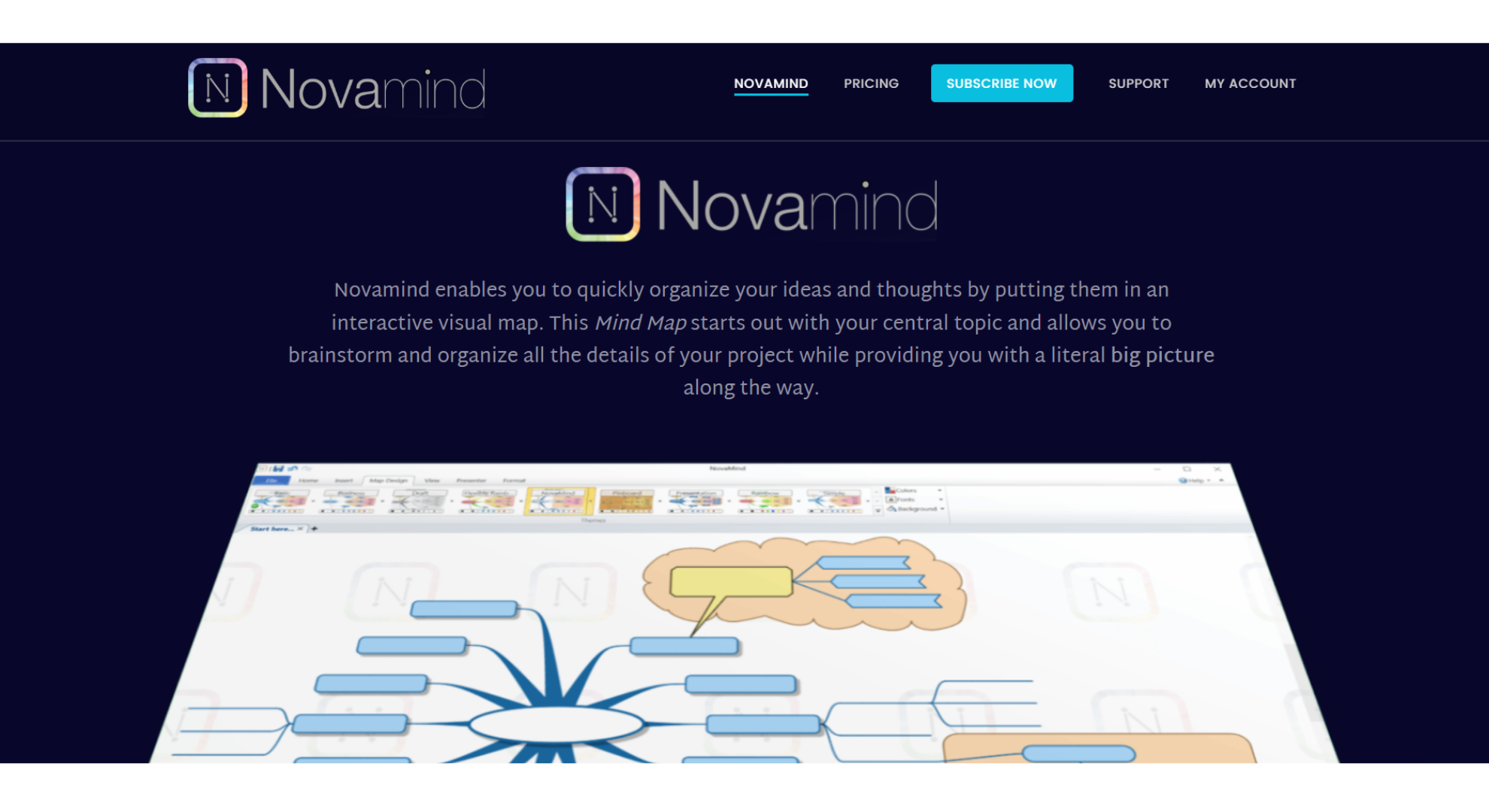
Why it stands out
Novamind is a veteran desktop mind mapping tool that has been around for years, offering a straightforward, visual approach to organizing ideas. Its simplicity and focus on offline map creation make it appealing to individual users or small teams who prefer a lightweight tool without the complexities of modern cloud platforms. While Novamind’s cloud service was discontinued, the desktop application still provides a fast, distraction-free environment for brainstorming, outlining, and planning.
Key Features
Quick, visual map creation with intuitive drag-and-drop interface.
Legacy desktop installers available for Windows and older macOS versions.
Supports basic diagramming, outlining, and presentation features.
Pros
Minimal learning curve; ideal for solo users or small teams.
Lightweight and distraction-free, making it suitable for focused mind mapping sessions.
Works fully offline, so no dependency on internet connectivity.
Legacy versions can still run on older machines, providing compatibility for users with older hardware.
Cons
Cloud service discontinued, limiting collaboration and online sync options.
No built-in generative AI, so users cannot automate map expansion, summarization, or AI-driven insights.
Aging interface and feature set feel dated compared to modern AI-first alternatives.
Support and updates are limited, meaning any new issues may not be addressed promptly.
Pricing
No active cloud pricing; desktop versions vary depending on legacy availability.
Previously sold as a one-time purchase for offline use.
Find the perfect match for your workflow
Comparison at a Glance
| Tool | Entry price | AI quota | Stand-out strength |
|---|---|---|---|
| MindMap AI | From $3.74/mo (yearly) | 2,000–5,000 credits/mo | File-to-map + Copilot Chat. |
| MindMup | $2.99/mo (Personal Gold) | – | Cheap, cloud-first collab. |
| Markmap | Free | – | Markdown → mind map. |
| Inspiration | One-off licence | – | Education-focused mapping. |
| MindMapper | $100–$249 (perpetual) | – | Windows planner + mapping. |
| Novamind | (legacy) | – | Simple offline mapping (legacy). |
FAQ
Q: Why look for alternatives to SimpleMind in 2025?
A: SimpleMind is excellent for clean layouts, free-form placement, and cross-platform use, but it lacks AI automation, multi-format imports, and deeper collaboration. Users who want faster brainstorming, AI-powered summarization, or automated branch expansion often prefer alternatives like MindMap AI.
Q: How does MindMup compare with SimpleMind?
A: MindMup is great for quick, cloud-based collaboration with Google Drive integration. However, it doesn’t include AI for automatic mapping or summarization. MindMap AI complements collaboration with smart automation, making it better for users who handle complex research or content-heavy projects.
Q: Is Inspiration a good choice for education?
A: Yes, Inspiration is widely used in classrooms for lesson planning and concept mapping. However, it doesn’t have AI features for faster content generation. Educators who need quick, AI-generated study maps from notes, PDFs, or lecture recordings can use MindMap AI for more efficiency.
Q: Which SimpleMind alternative gives the best overall value?
A: MindMap AI provides the best balance of features and price. Starting at just $3.74/month (yearly billing), it includes 2,000–5,000 AI credits, multi-format input, Copilot Chat, and export flexibility. Compared to SimpleMind’s one-time purchase, MindMap AI delivers greater long-term value through automation and ongoing updates.
Final Takeaway
SimpleMind remains a reliable and distraction-free choice for traditional mind mapping. But if you’re seeking more innovation, the top SimpleMind alternatives introduce automation, advanced collaboration, and creativity that SimpleMind doesn’t fully cover.
MindMap AI is a top choice here: it generates editable mind maps directly from PDFs, text, videos, audio, images, CSVs, and more. With built-in features like AI Expand, Summarize, and Focus Topic, it transforms brainstorming into actionable plans in seconds. Exports to PNG, SVG, PDF, Markdown, and CSV make sharing effortless, while its cloud-based design ensures easy access across devices.
For students, professionals, and teams who want a future-ready mapping tool, MindMap AI is one of the most powerful SimpleMind alternatives in 2025.





